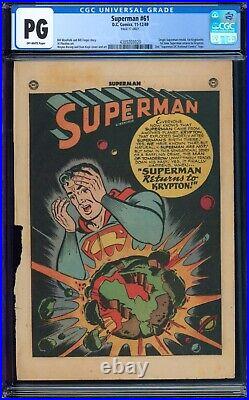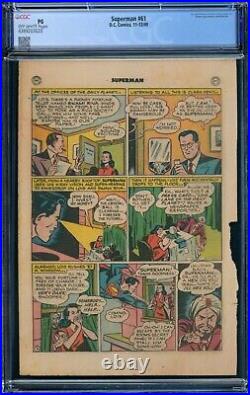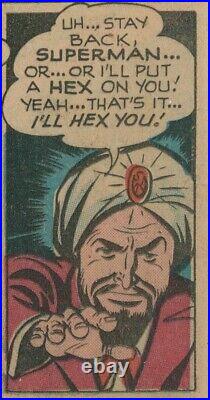



Fresh encapsulation, with no visible defects. The Kryptonite is the red stone on the swami’s turban. Page collecting is an emerging investment strategyand hobby in the comic book industry. There are a number or reasons for this. Page collecting allows a means of owning a partof key issues at a much more affordable price. One can see sentinel moments in the history andstoryline of a character that can’t be viewed from an encapsulated whole comicbook. Page collecting can serve as a complement toowning a higher grade issue that the page is from. There is a relative scarcity of key individuallygraded pages. Actual encapsulation of only pages is relatively new with third partygrading companies. The key issues that the pages are from can be rare to begin with, especiallyGolden Age examples. The key issues that are already encapsulated are usually at a grade too highfor one to want to separate the key pages. As this is an emerging phenomenon, percentage increase of these bargain examples is likely higher in the futurethan other means of comic book investing. In the hallowed halls of comic book history, there exists a pivotal moment captured within the pages of Superman #61, a publication that heralded the introduction of Kryptonite to the world of Superman. This radioactive mineral, with its deadly glow and ominous implications, not only changed the course of Superman’s narrative but also left an indelible mark on broader cultural perceptions. For Superman, the introduction of Kryptonite was a watershed moment. Until then, he had stood as the paragon of invincibility, his superhuman abilities seemingly unmatched. However, with the discovery of Kryptonite, writers found a potent tool to introduce vulnerability into his story. No longer was Superman impervious to all threats; the glowing substance became his Achilles’ heel, a weakness that added layers of drama, tension, and character depth to his adventures. Beyond the comic book panels, Kryptonite’s influence seeped into popular culture, becoming a symbol of weakness or vulnerability universally recognized. Its inclusion in Superman lore expanded the rich tapestry of his backstory, weaving in elements from his shattered home planet of Krypton. This expanded lore fueled adaptations across various media, ensuring that Kryptonite’s glow remained a fixture in the collective imagination of audiences worldwide. Imagine possessing the very page depicting the first image of Kryptonite-a historical artifact steeped in comic book lore. This page not only represents a creative milestone but also serves as a tangible connection to the origins of a character who transcends comic book pages. It’s a collector’s dream, a piece of cultural history that speaks to the enduring impact of a single idea within the realms of comics and beyond. In essence, Superman #61’s introduction of Kryptonite is more than a plot twist; it’s a narrative catalyst that propelled Superman into new realms of storytelling while leaving an indelible mark on popular culture. Owning the page showcasing this pivotal moment isn’t just ownership of paper and ink-it’s a testament to the creativity, imagination, and timeless allure of comic book storytelling.

